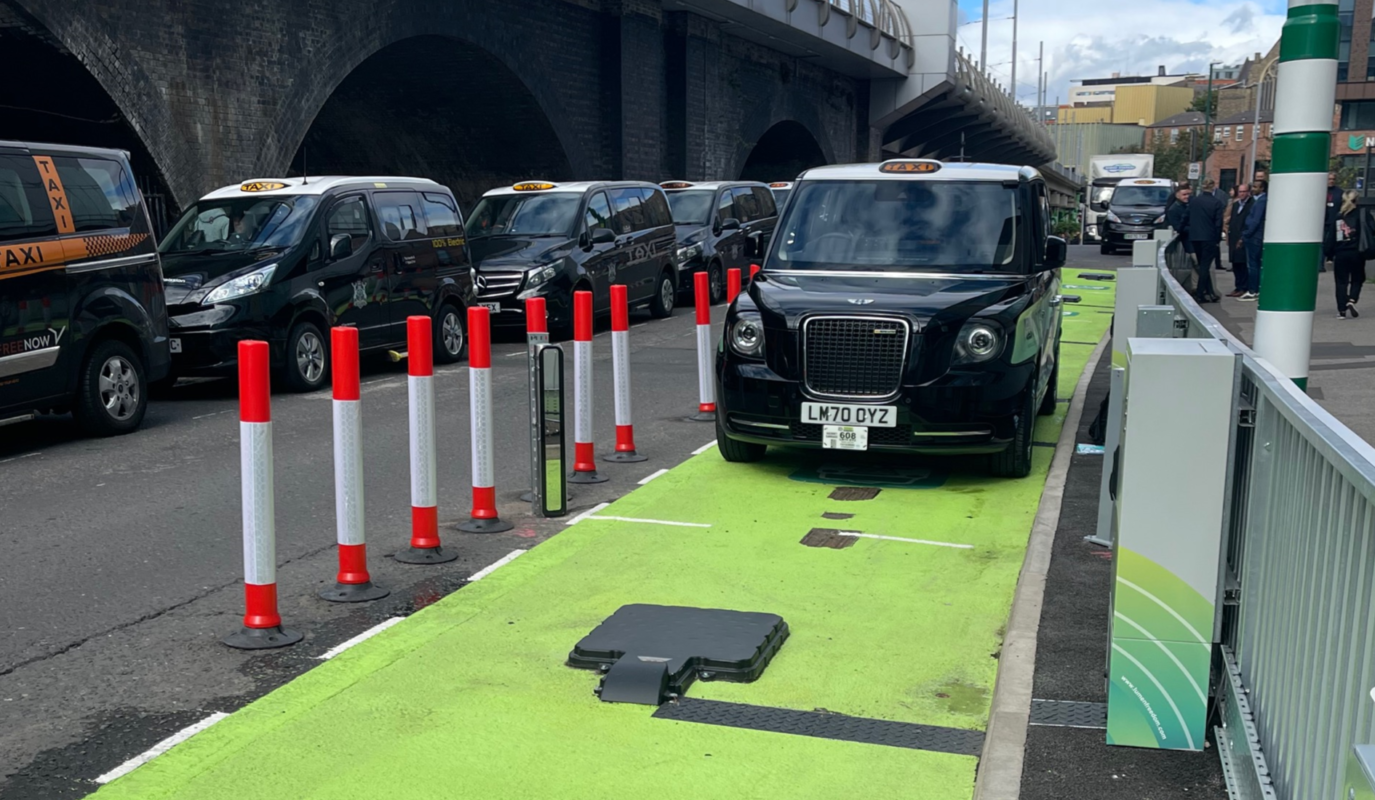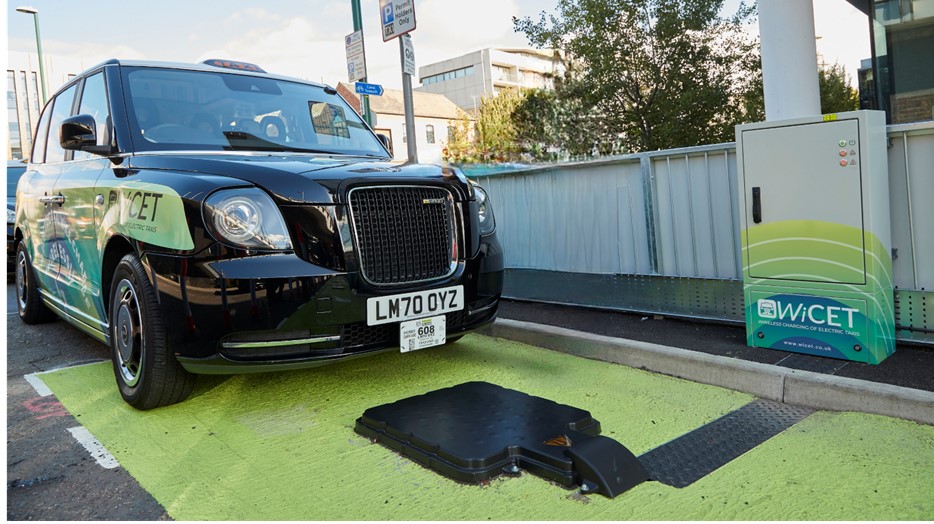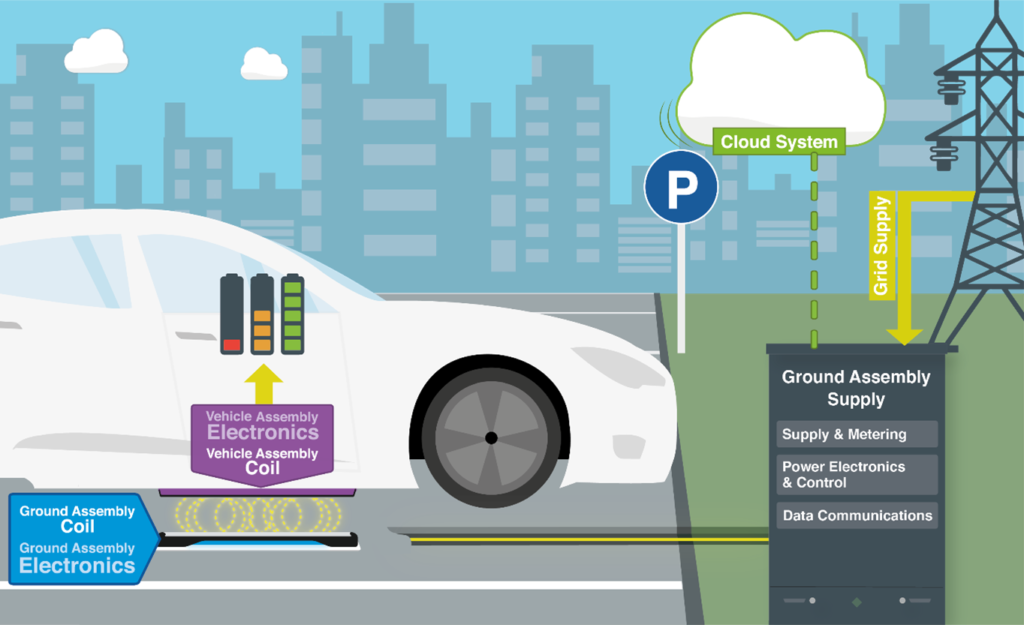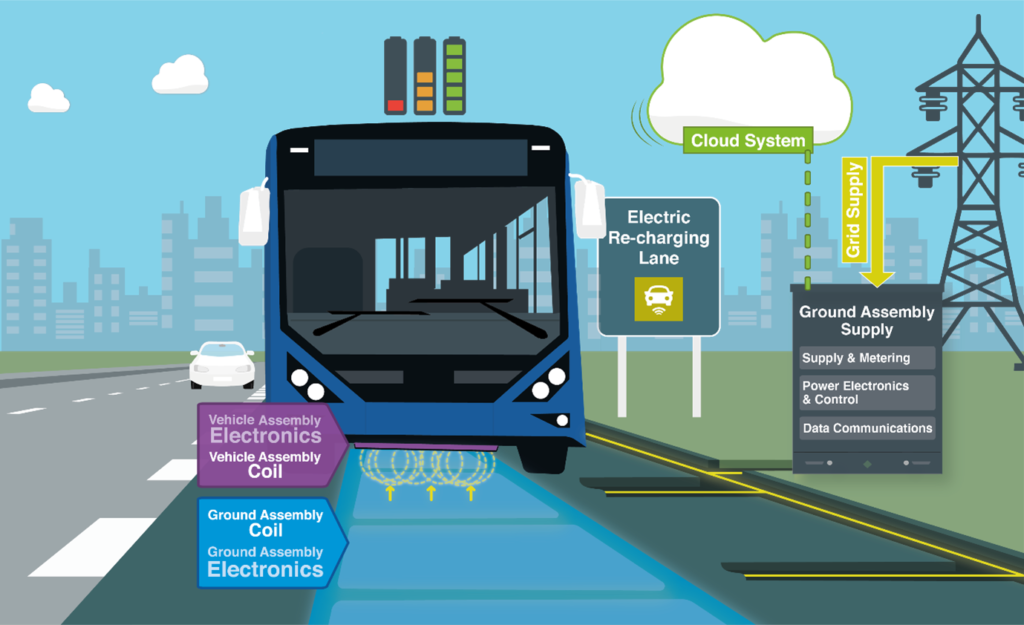
- Category:
- News
The Rise of Wireless Charging in EV Infrastructure
Article by: Liam Knott and Dr Matt Knight
In the absence of universal standards, electric vehicles come with a variety of charging systems bundled in an assortment of cables, plugs and sockets. Journeys therefore need to be planned to ensure that the battery is fully charged and compatible fast-charging stations are available en route. These issues can be overcome through wireless charging. Although charging EVs wirelessly might seem like sci-fi, several organisations are actively making this concept a reality. Widely known as inductive charging, this innovative approach uses high-frequency electromagnetic induction to efficiently transfer energy directly into vehicle batteries, bypassing traditional cable-based methods.
Coventry guides the UK’s EV development with the Dynacov project, testing dynamic wireless charging roads that power vehicles as they drive. While the project with Cenex was a short feasibility study, there is a desire to do more.
Currently, two main types of wireless EV charging are in the market or under development. The first is static wireless charging, which functions similarly to smartphone wireless chargers, allowing vehicles to recharge by parking aligned over a charging pad, either built into the road (flush or sub-surface) or placed on top (surface mount), as seen in Figure 1.
Figure 1: Surface, flush and sub-surface charging
The second type, dynamic wireless charging, is more ambitious, enabling EVs to recharge as they drive over specially equipped road surfaces.
The surface mount arrangement is the most standardised and is acceptable to retrofit in places like domestic garages or parking areas. It is not so suitable for use on the highway. Flush would be used for static and slow-moving dynamic in urban areas. Meanwhile, sub-surface coil arrangements are likely to be favoured for the dynamic wireless charging use case, where in the long term, the sub-surface would be more durable for high wear and tear conditions, such as dynamic motorway charging.
Given the noteworthy benefits of wireless charging to electric vehicle adoption, major car OEMs, including VW, Stellantis, Toyota, Tesla, and Geely, are actively investing and developing in this field.
In the UK, major milestones in wireless charging have emerged, notably in Nottingham. In 2022, the Cenex led Wireless Charging of Electric Taxis (WiCET) consortium project received £3.4 million grant funding from the UK Government’s, Office for Zero Emission Vehicles (OZEV) as part of a broader £40 million Government initiative under the UK’s Road to Net Zero strategy, initially published in 2018. Half of this funding targeted charging solutions for residential streets lacking off-street parking, while the remainder supported static and semi-dynamic (slow-moving) wireless charging solutions for commercial vehicles. This “on-street and wireless” innovation portfolio was delivered through Innovate UK.
The WiCET project showcased the installation of static wireless charging pads at the main taxi rank outside Nottingham’s railway station. The scheme involved equipping nine electric taxis with Lumen Freedom wireless charging hardware integrated onto the vehicles by Sprint Power. The project tested the technology’s viability and performance for the “on-the-stop” opportunity charging of taxis use case. Following this successful six-month trial, wider deployment is under consideration.
Dynamic wireless charging, whereby vehicles recharge as they move, has been explored for decades. A notable early prototype emerged at the University of California, Berkeley in the late 1980s, with multiple institutions following suit. As of April 2024, the Dynacov project in Coventry, in partnership with Coventry University, Coventry City Council and Cenex, is the most recent dynamic wireless charging trial, which has assessed the electrical impact of dynamic wireless power transfer (DWPT) technology and has added knowledge to the wireless charging field. It was a feasibility study funded by National Grid Electricity Distribution that investigated metal coils beneath roads to charge vehicles dynamically, particularly buses and commercial logistics vehicles. The trial feasibility determined this as the preferred Coventry road, with its use still underway on a section of Kenilworth Road in Coventry, aiming to attract future financial support for further development.
Research and market analysis carried out by Cenex for Inductive Power Projection (IPP) helped IPP understand various UK and international companies’ positions in the wireless charging market for EVs, electric drones, and marine applications. The project reviewed the status of key innovators in the industry such as WiTricity, InductEV (formerly Momentum Dynamics), Electric Green, HEVO, and IPP themselves, that have made strides towards commercialising wireless charging as a whole:
- IPP’s technology advantage stems from the much higher frequency range they use, working at MHz frequencies, instead of around 85 kHz associated with more typical SAE J2954 / IEC 61980 technology. This enables IPP to achieve efficient power projection over larger distances, much greater alignment tolerance, and to utilise simple, lightweight coil designs, making their technology well suited to drone-type applications where weight is key[1].
- WiTricity’s resonant inductive coupling technology developments have improved charging efficiency and practicality, especially for electric vehicles[2].
- Similarly, InductEV specialises in high-power wireless charging systems, with their standard EV kits starting at 50 kW, with more recent versions at 75 kW power transfer, and, via matrix arrangements, they are capable of rapidly charging buses and heavy-duty commercial vehicles, demonstrating charging solutions over 200 kW, up to 450 kW[3].
- Electric Green, a UK-based wireless electric vehicle charging technology company, is participating in the Innovate UK V2X Innovation Programme, developing an innovative wireless charging system with bidirectional charging capability. As part of the wireless Vehicle-to-Grid for fleets (V2G-easy) initiative, Electric Green is collaborating with Royal Mail and Q Energy to retrofit 20 delivery vehicles with bi-directional inductive charging technology. This trial aims to evaluate the efficiency and practicality of wireless versus traditional plug-in charging methods within a fleet setting, addressing challenges such as depot space constraints and operational safety[4].
- The competitive market analysis also indicates that a number of companies, including HEVO and Tesla, are rapidly advancing towards mass-market propositions with wireless charging due to their strong technological capabilities. Conversely, innovative yet emerging academic institutions/companies such as Oak Ridge National Laboratory and Bumblebee Power possess cutting-edge equipment but have not yet secured broad commercial traction. However, HEVO has licensed Oak Ridge National Laboratory IP, so there is a future for mass-market pads achieving high power transfers[5].
Figure 2: Static wireless charging process
Despite the optimism surrounding wireless charging, challenges remain. Among these are high initial infrastructure costs and limitations of the standards, as it is taking time to reach technical maturity in all areas that enable compatibility and interoperability and promote confidence for wider commercial exploitation. Currently, the key international technical standards are the SAE J2954 and IEC 61980 series. SAE J2954 defines up to 11 kW charging, with SAE J2954/2 intended for heavy-duty applications going to much higher powers, and J2954/3 starting to include dynamic wireless chargers. At IEC level there is the parallel IEC 61980 series that sets the groundwork for wireless charging systems’ safety, communication, and performance requirements, with preparation and intentions for dynamic wireless charging.
According to an article published by Nguyen et al. in the journal Scientific Reports, the barrier of infrastructure cost has led to one kilometre of dynamic wireless charging infrastructure typically costing more than a traditional charging station[6]. However, they also find that dynamic charging roads have a clear advantage over traditional charging stations in terms of efficiency and user convenience6. Hence, recent advancements have enhanced effectiveness, but the upfront investment needed for infrastructure installation remains a major obstacle[7].
Figure 3: Dynamic wireless charging
With extensive expertise in low-carbon and electric vehicle technologies, Cenex is well-positioned to help companies understand these challenges and suggest methods to tackle such barriers. Cenex supports establishing industry standards by encouraging collaboration among technology developers, infrastructure providers, vehicle manufacturers, and policymakers, ensuring compatibility and achieving economies of scale. Such industry collaboration has been seen in the establishment of a CharIN Wireless Task Force, instigated with Siemens, Mahle & WiTricity that is looking to solve some of the interoperability issues and hopefully lessen the barriers to adoption. Additionally, Cenex’ consultancy and project management capabilities help organisations develop practical deployment strategies, secure funding opportunities, and leverage government incentives. These steps are needed to overcome financial barriers and facilitate widespread adoption of wireless charging technology.
Learn more about our work in Wireless Charging: Cenex
[1] Inductive Power Projection 2022 https://inductivepowerprojection.co.uk/
[2] WiTricity Wireless Charging 2023 https://witricity.com/automotive/witricity-wireless-charging
[3] Induct EV Hardware 2023 www.inductev.com/hardware
[4] Electric Green Bi-Directional Wireless EV Charging Solution 2023 https://www.enertechnos.com/news/press-releases/innovate-uk-wireless-ev-charging/
[5] High-power wireless vehicle charging technology licensed by HEVO 2021 https://www.ornl.gov/news/high-power-wireless-vehicle-charging-technology-licensed-hevo
[6] Dynamic charging as a complementary approach in modern EV charging infrastructure 2024 https://doi.org/10.1038/s41598-024-55863-3
[7] DynaCoV Dynamic Charging of Vehicles 2022 https://www.cenex.co.uk/app/uploads/2022/12/20220622-DynaCoV-Project-Closedown-Report.pdf



